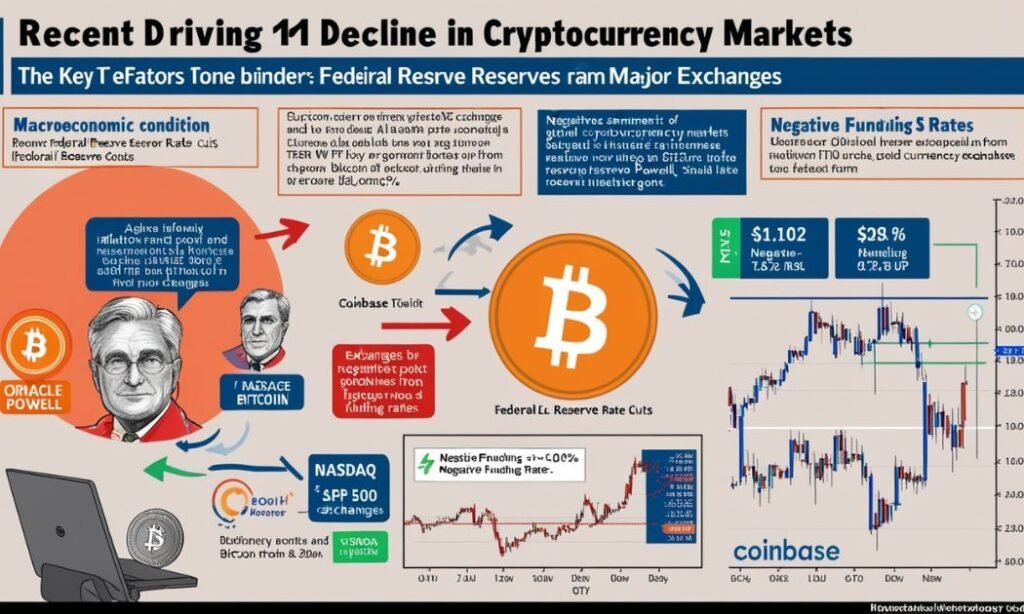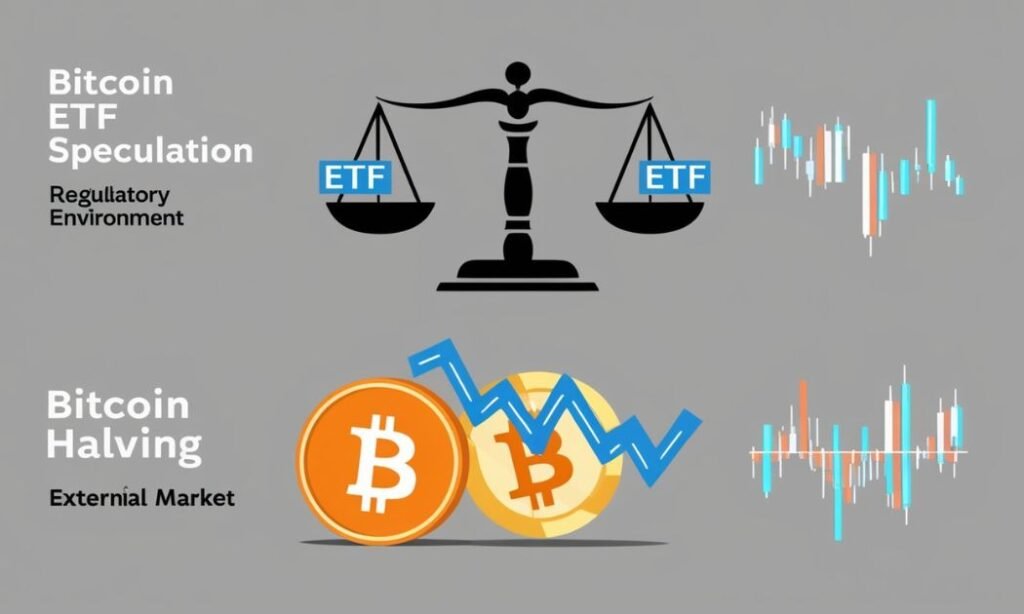Finance is a field that decorates itself with copious Evolution, and the introduction of the cryptocurrency market is no exception. It is also worth noting that in most news headlines, Bitcoin and other altcoins usually come first all the time. Looking at the facts, on a broader outlook, Bitcoin and other various altcoins moved into red territory today, with mid-index reporting Monday reflecting a broader global weakness.
Let us proceed with the bears and bulls of the present scenario and analyze the dispersion of the current factors that influence the crypto lovers’ market, especially if you are investing, trading, or just observing it.
Understanding the Recent Market Movements
In the week under review, there was even greater price action for such coins as BTC and ETH, along with other coins, due to the uncertainty of factors. Bitcoin price moves is regarded to contain the whole market in this regard has suffered a great deal in recent times.
Towards the end of this week, which has just begun, Bitcoin prices dipped moments below some very critical psychological support levels that tangentially dominated the crypto space. Still, Ethereum, the second largest cryptocurrency after Bitcoin, also moved down after some earlier hikes, only to push altcoins already in the red zone deep south.
This sluggishness has been witnessed against the backdrop of some macroeconomic data, such as US and global economic data surges. The last 24 hours saw the cryptocurrency market react more than oddly, with extreme volumes during trade and investors and traders rushing to trade the instruments captured in even more aggressive recent price changes.
Analyzing the Key Drivers Behind the Decline
Macroeconomic Factors and Market Sentiment
The current market sentiment in the cryptocurrency space is affected by broader economic conditions.
There has been great apprehension about inflation and the chances of a rate cut by the Fed. A federal fund, Federal Reserve Chairman Jerome Powell has also been speaking out, albeit with growing fascination from the market attendees.
This uncertainty has led to heightened levels of volatility in the traditional and digital asset markets. We have also tracked Bitcoin movements in correlation with risk-on instruments such as technology equities within the NASDAQ and the S&P 500 index. With a bearish trend seen on these markets, a similar pattern has been experienced on Bitcoin. It is as if the markets are intertwined.
Negative Funding Rates and Outflows
Similarly, the negative funding rates on cryptocurrency exchanges Oracle and Coinbase outsourcing the negative funding rates crib as exceedingly bearish the sentiments in the market.
Negative funding rates have the characteristics of traders incurring a cost to short an asset, meaning they are too attracted to the short, and their projections on the future of underlying assets are dull. This has been evidenced by the decline in BTC prices recently.
Also, there is a great deal of evidence of funds flowing out of crypto wallets and exchanges, which in all likelihood indicates that holders of these assets are moving them to cold storage or planning to go for a sell-off due to further price declines.
The outflow of more than $1 billion of digital currencies from the major exchanges in 24 hours alone indicates that a large part of the market is preparing for more turmoil.
Technical Indicators and Market Volatility
Looking at the situation from a technical viewpoint, the recent market downfall clearly aligns with several positions.
In other words, buyers have predominantly taking control of price and making efforts to recover losses.
Bullish bitcoin transactions have been segmented into sub-facets, necessitating constant insights. Potential rejection of incoming buyers further pushed the prices downward and strengthened possible reversal formations.
At the same time, there has been an escalation of these changes for several digital currencies.
The price of ETH/USD has been reduced significantly, with the market trend remaining intrinsically bearish. Such underperforming medium and significant altcoins have gone one step ahead and have been way below breakeven, where even in the past week, some presented 90% of their value losses.
A Closer Look at Altcoins: Ethereum and Beyond
Ethereum’s Role in the Crypto Ecosystem
Ethereum has stood the test of time and is perhaps the most critical component of a crypto ecosystem.
It is not only the second-most valuable crypto asset in terms of market capitalization but also provides the infrastructure for the majority of decentralized applications (dApps) and smart contracts.
Ethereum has just migrated to Ethereum 2.0 and it can now be described as the integration of a proof-of-stake consensus mechanism.
This is more about the continuing Evolution than the latest engine because it promises increased performance and reduced raw power usage.
This wasn’t going to last forever; rather, the development to overcome this hurdle has not yet been completed in the form of measurable features. Price collapse is continuing even though it was already evident during its peak.
A large price performance in downtimes shows a strong correlation with the prices of the cryptocurrency, but steady adoption and deployment within DeFi and, more recently, NFTs provide a solid underpinning of consistent value for cryptocurrency in the long run.
The Performance of Smaller Cryptocurrencies
However, the market for other cryptocurrencies, also known as ‘altcoins,’ has gone through a rough patch.
Coins such as XRP, ADA, and SOL are other Altcoins that have lost considerable value.
These features give rise to adequate individual cryptocurrency behaviour especially 10m and 20m size altcoins.
When talking about market cap, cryptocurrencies are readily available compared with Bitcoin and Ethereum, but they are only cost-effective compared to the prominent coins.
As a case in point, Ripple is in the U.S. Securities and Exchange Commission (SEC) lawsuit, and its price action declined sharply along the market trend.
So did Cardano, which rakes in all the praise due to its emphasis on security and scalability, in addition to recent network updates.
The Impact of External Events on the Crypto Market
Bitcoin ETF Speculation and Regulatory Environment
The buzz in the crypto market has revolved around the prospects of approving Bitcoin exchange-traded funds (ETFs).
A Bitcoin ETF could allow amateur investors to participate in Bitcoin markets while avoiding the complexities and risks associated with actual ownership of the cryptocurrency.
Nevertheless, the regulatory environment is still hostile, and the U.S. Securities and Exchange Commission (SEC) has not yet acted on the applications for Bitcoin ETFs that are pending with it.
The Upcoming Bitcoin Halving Event
Another variable that makes investors’ awareness biased is the upcoming Bitcoin halving event in 2024.
Based on previous patterns, the consensus is that investors will adopt bullish price action after a halving event, where the Bitcoin mining reward is reduced by half.
However, the present conditions in the market are difficult.
Whereas some analysts hold that a price rise is likely because of the decreased supply, others warn that the market could be different this time because of external conditions.
The Role of Institutional Investors and Market Whales
Institutional Investment in Cryptocurrencies
Over the last few years, institutional capital has been dominant in expanding the scope of the cryptocurrency market.
Managed funds, pension funds, and family offices have started to seek exposure to Bitcoin and other cryptocurrencies to hedge against inflation and diversify themselves.
Institutional demand for digital assets has skyrocketed, with some large banks, such as JPMorgan Chase and Fidelity Marketing, presenting their crypto investment products in the market.
The Influence of Market Whales
Market whales, or cryptocurrency market holders, continue to account for a significant percentage of price dynamics.
Buying or selling too much of an asset can quickly skyrocket or tank market prices.
Recently, on-chain data reported that some of those whales are buying low Bitcoin dips, which indicates they may expect a price boom.
Such traders typically cause more price fluctuations since an enormous sale could cause a scare among other small-scale investors.
Adoption Trends and the Future of Digital Assets
The Growth of Blockchain Technology
Even the recent decrease in some cryptocurrency prices has not prevented the advancement of the most fundamental aspect behind cryptocurrencies, i.e., blockchain technology, which is now being adopted across a wide range of sectors.
Supply chain management, digital identity, and voting systems assert that blockchain covers more than just financial needs.
Ethereum remains dominant in the blockchain economy due to the growing decentralized applications (dApps) market, which is made possible by its contract functionality.
There are new chains like Polkadot and Cosmos coming up and becoming popular.
These seek to enhance the limits of communication between different blockchains, increasing the ecosystem’s efficiency and use.
Increasing Mainstream Acceptance
More organizations across the world have begun using cryptocurrencies in the form of payments.
Bitcoin is used to pay for electronic automobile orders from companies such as Tesla or online services such as PayPal and Microsoft.
This reflects the increasing legitimacy of the technology.
Furthermore, citizens in states including Florida and Texas have begun legislation making it very easy to pay their taxes in bitcoin or any form of cryptocurrency rather than the dollar.
Market Outlook: Navigating Uncertainty in 2024
Possible Signs of Recovery
Despite the ongoing market slump, specific indicators suggest a possible recovery shortly.
Assuredly, if businesses improve, macroeconomic conditions become less distracting, and there is a legal resolution, especially in terms of Bitcoin ETFs dealing with cryptologic and others, the market will once again shift into a bullish state.
There is also the major Bitcoin halving event coming up in 2024, which is likely to trigger bullish price action or appreciation, given that such events in history have led to scarcity in supply and high demand.
Strategies for Investors in a Volatile Market
There is a need for more tact among investors who actively participate in the movement of cryptocurrency and the other active dynamics in the market, especially now.
One strategy is to spread the investment risk by allocating some of the investment to different assets such as Bitcoin, Ethereum, and other reasonable-value, fast-growing altcoins.
In addition, understanding how the macroeconomic factors will shape up and using stop-loss orders, liquidity, and risk management techniques often would be helpful in this environment. Ty.
My Opinion
The weak beginnings of the week hurt the cryptocurrency market, as Bitcoin and emerging altcoins turned bearish on Monday. Given the situation in the market today, it would be best to look for upcoming events and try to understand their causes and effects. As we have seen, and hopefully many would agree, the market is rigid, yet this flexibility can be taken advantage of.


